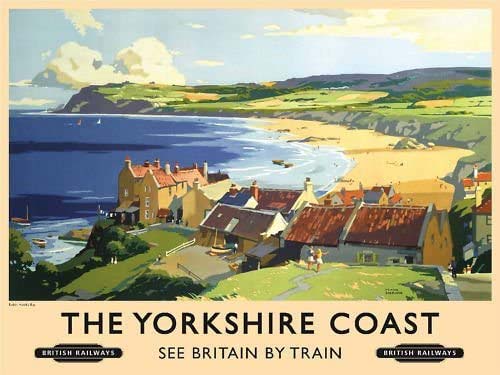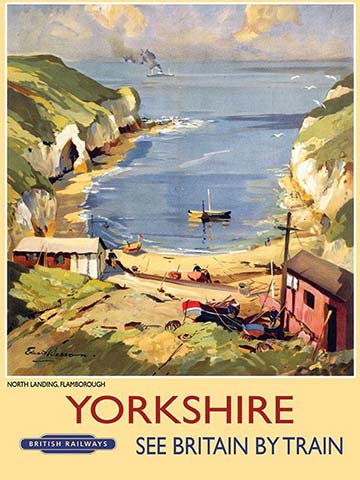Local History Society Report
Around the UK in classic railway posters
Speaker: Jane Ellis
Saturday, 27 March 2021
As the desire to venture beyond our local streets grows, members of Hebden Bridge Local History Society gathered around computer screens for the final Zoom of the season, to feed that desire with a feast of colourful railway posters promoting the excitement and promise of a journey by rail.
The speaker, Jane Ellis, who is actively involved with the Industrial History Section of Yorkshire Archaeological & Historical Society, has been running the Yorkshire branch of the Railway Ramblers’ Club for over 25 years. She explained that the “golden age” of the railway poster was probably between the wars, but their history is almost as old as the railways. As soon as numbers of passengers began to throng in the stations, adverts for a multitude of products covered the walls, to the extent that ‘Bovril’ might have looked like the name of your stop at some local station.

At first the railway companies produced posters promoting their special excursions, giving information about timetables and prices and enticing people to take the train to the races or to go Christmas shopping. Soon however the railway companies seemed to engage in dreams of the romance of travel, with stylish depictions of famous beauty spots and heritage sites. ‘See Britain by Rail’ became the slogan, featuring attractions like Bamburgh Castle and York Minster, the wild hills of the Peak District and mountains of Scotland as well as bracing Skegness.
The competing railway companies began to employ noted artists, including members of the Royal Academy such as Laura Knight who depicted the Yorkshire coast, and Norman Wilkinson whose art used a powerful graphic images with limited colours to capture the essence of a place such as Anglesey or Inverness for LMS Railways.
The work of another notable artist, Terence Cuneo, was of a more dramatic style, often depicting the glamour of the journey and the power of the engines steaming through the landscape. It seems he took his work seriously as he was photographed perched on the girders of the Tay bridge to get the best viewpoint of the oncoming train.

Railway posters emphasised the outdoor life as trains were seen as the ideal way to get out in the country to go rambling, horse riding or playing golf. Seeking health also led to the expansion of spa resorts, and many railway posters feature the attractions of Harrogate and Bath.
Thomas Cook was one of the first to see the leisure potential of trains, and railway companies competed with their prime hotels such as the Waverley in Edinburgh and Morecambe’s art deco Midland Hotel. The locomotives themselves were glamourised, given identities such as the Royal Scot, the Brighton Belle and the Flying Scotsman and starring in the railway posters. The fancy dining cars offering sophisticated meals were also a feature of this glamorous age.
A special sub-set of railway posters are the carriage prints – the letterbox shaped pictures that filled the gap between seat back and luggage rack and gave passengers something to look at instead of the faces of those sharing the compartment. The heyday of the railway posters was between the two world wars, and by the time of the second world war instead of being enticed to see Britain by rail, people were being asked ‘Is your journey really necessary?’ Something which is all too familiar these days!
Details of the talks programme, publications and of archive opening times are available on this website and you can also follow the Facebook page.
With thanks to Sheila Graham for this report
See also

